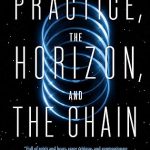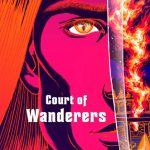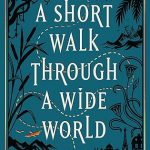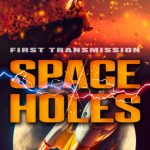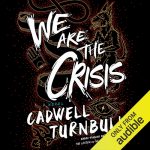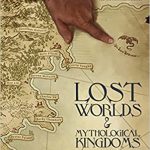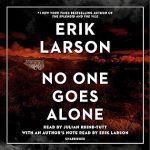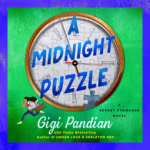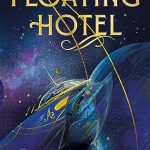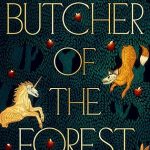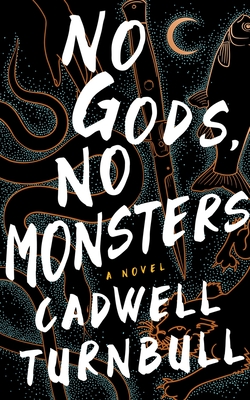 No Gods, No Monsters (The Convergence Saga, #1) by Cadwell Turnbull
No Gods, No Monsters (The Convergence Saga, #1) by Cadwell Turnbull Format: audiobook, eARC
Source: supplied by publisher via NetGalley
Formats available: hardcover, ebook, audiobook
Genres: fantasy, horror, science fiction, urban fantasy
Series: Convergence Saga #1
Pages: 387
Published by Blackstone Publishing on September 7, 2021
Purchasing Info: Author's Website, Publisher's Website, Amazon, Barnes & Noble, Kobo, Bookshop.org
Goodreads
One October morning, Laina gets the news that her brother was shot and killed by Boston cops. But what looks like a case of police brutality soon reveals something much stranger. Monsters are real. And they want everyone to know it.
As creatures from myth and legend come out of the shadows, seeking safety through visibility, their emergence sets off a chain of seemingly unrelated events. Members of a local werewolf pack are threatened into silence. A professor follows a missing friend’s trail of bread crumbs to a mysterious secret society. And a young boy with unique abilities seeks refuge in a pro-monster organization with secrets of its own. Meanwhile, more people start disappearing, suicides and hate crimes increase, and protests erupt globally, both for and against the monsters.
At the center is a mystery no one thinks to ask: Why now? What has frightened the monsters out of the dark?
The world will soon find out.
My Review:
The title of this book is a play on the old anarchist slogan, “No Gods, No Masters.” It’s a reference to the belief that no one should be above anyone else and no one should be below anyone else. That all humans should be equal.
The “monsters” that have suddenly come out of wherever they’ve been hiding themselves have adopted the old slogan to put forward the idea that monsters aren’t separate from the rest of the population, that neither humans nor monsters should be above or below each other, that all should be equal.
It’s a question that has come to the forefront in the wake of an event that the amorphous, unreliable narrator of this story refers to as the “Fracture”, when a group of shifters – werewolves and their kith and kin – staged a peaceful demonstration of their ability to shift from wolf to human. A demonstration that took place in front of a bunch of cops and other bystanders, and was filmed in its entirety.
The video of the demonstration appeared very briefly on the internet, showing the full change from a line of wolves to a line of humans. The video went viral. Everybody saw it. People were debating the existence of monsters and what it meant.
At least until all the copies of the video were edited to eliminate the parts that showed the change. And the debate shifted, from people discussing what they saw to people arguing about whether or not they’d really seen it. About whether or not monsters really exist at all.
But even with and beside and under the debate, the world is changing. The “Fracture” has had an effect on everyone, whether believer or skeptic, monster or human. Even for those who have chosen not to rock their familiar world by admitting that there might be more things on heaven and earth than were dreamt of in anyone’s philosophy, nothing and no one will ever be the same.
Escape Rating B: There are multiple ways of looking at this story, because it feels like it says different things depending on how the reader approaches it, beginning with the debate about whether this is science fiction or fantasy. To which the answer is probably “Yes”.
The point of view characters, whether monster or human, focus the story on the perspective of the “other”, where being a monster is just one additional axis upon which a person can be considered “other”.
The story opens with the death of Laina’s brother Lincoln, where Laina is looking for the truth about why the cops shot him. Laina expects to find yet another police cover up of cops killing a black man for no particular reason. What she finds is a video of really, truly, seriously frightened cops shooting an out-of-control werewolf who only turns into her brother after he’s dead. That the video is left for her by an invisible woman adds to Laina’s desire for answers to questions she hadn’t even known were possible.
The story spins out from there. Laina releases the video. Mysterious forces edit the video. More monsters reveal themselves to their friends and family. More people have questions and search for answers – only to find that those answers are more dangerous than they ever imagined.
The story doesn’t so much proceed as it spirals outward in ever increasing circles and greater and greater number of perspectives, from the members of a co-op who learn that one of the members is a techno-mage and that factions of monsters are hunting all of them to a young politician and secret weredog and who is still desperate to learn what happened to the parents who disappeared when she was a child – only to discover that the forces that broke them want to take and break her as well.
Conspiracy theorists learn the lesson about being careful what you wish for because you might get it. Or it might get you. That it takes a monster to catch a monster – as one of last week’s books explored much less seriously and considerably less well – and that the only ones capable of really damaging creatures who are seriously at the top of the food chain are others who are just the same.
The switches in perspective and narration made it a bit difficult to follow the story. They give a strong sense of the story being much bigger than what we see, but also make it harder to put everything in any kind of order. At the same time, because this is also a story of the multiverse, those hints that the situation is bigger than we imagine make a certain kind of sense.
Even if I occasionally wished we stuck with one perspective so we could figure out a bit more of what’s really going on.
One of the things that I kept coming back to in my own head was that we all know that there ARE gods and there ARE monsters, even if the gods are the kind that man creates in his own image and the monsters all walk on two legs all of the time. The certainty of both of those things does not prohibit the possibility that there are also gods or pantheons of gods of the omniscient and omnipotent variety, nor that some of the monsters that go bump in the night in fiction don’t also do it for real.
It becomes clear over the course of this story that the humans are capable of being way more monstrous than the actual monsters, and that the ones who believe they are godlike are the worst of all.
The end of the blurb leads readers to questions that the story itself doesn’t raise – at least not yet in the series. Why is this happening now? (At least for certain perspectives on exactly what “now” means.)
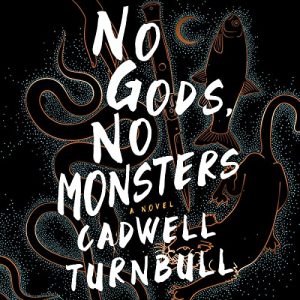 Speaking of perspectives, at least in the audiobook that I listened to they blurred into each other just a bit. The reader was good, and if his voice was intended to represent the unreliable narrator we begin and end the story with, he does a good job of representing that particular voice. But this story has a LOT of voices, all of whom are unreliable to one degree or another – some because they don’t know what they don’t know, and some because they don’t want to know what they don’t know – and the audio might have worked a bit better if there had been a few more narrators to help the listener keep track.
Speaking of perspectives, at least in the audiobook that I listened to they blurred into each other just a bit. The reader was good, and if his voice was intended to represent the unreliable narrator we begin and end the story with, he does a good job of representing that particular voice. But this story has a LOT of voices, all of whom are unreliable to one degree or another – some because they don’t know what they don’t know, and some because they don’t want to know what they don’t know – and the audio might have worked a bit better if there had been a few more narrators to help the listener keep track.
In the end, which is not an end but really just a pause, I’m intrigued. It feels like this book opens a tiny window into a much wider and deeper catalog of worlds and stories and possibilities and what ifs. This first book felt like a whole bunch of teasers and I want to see where they ALL lead.




